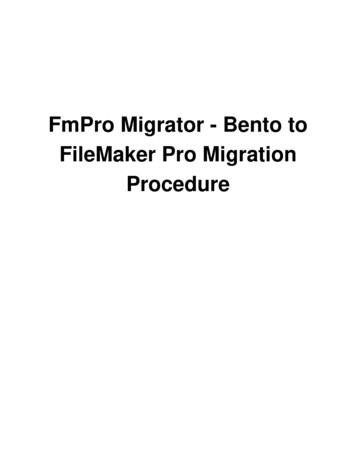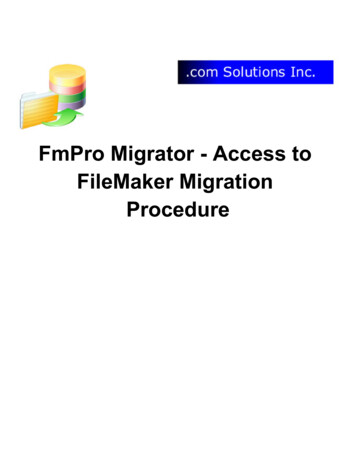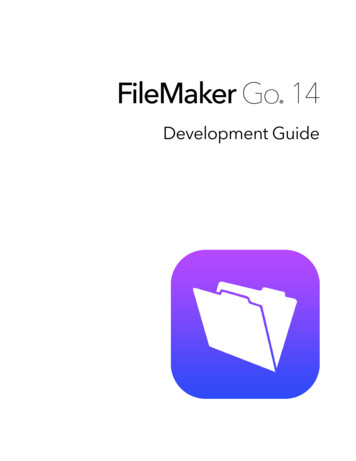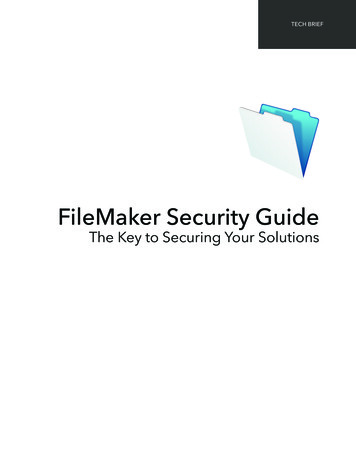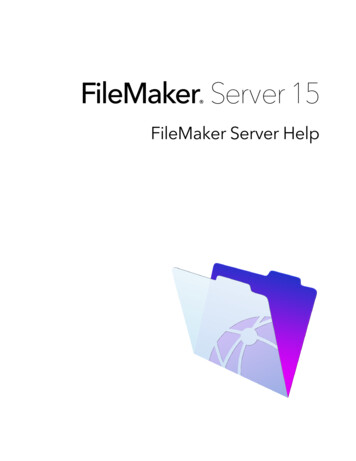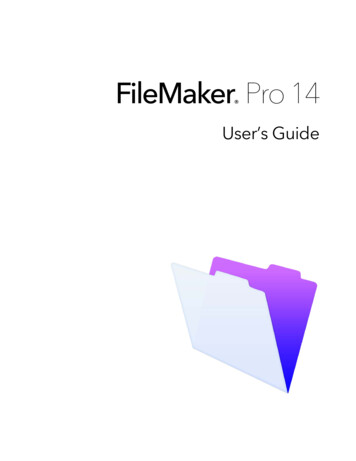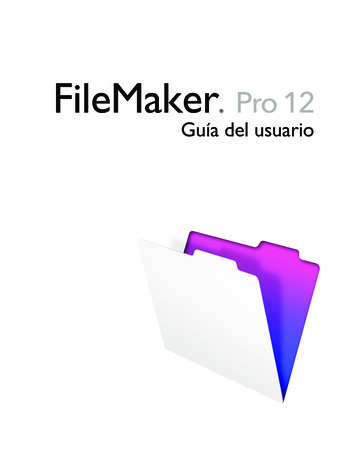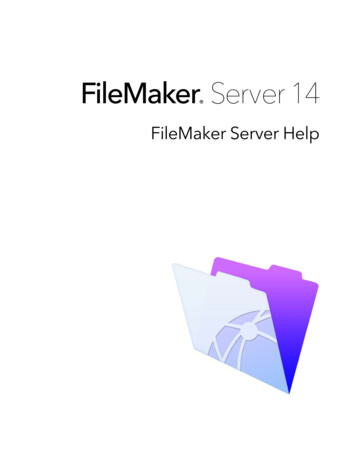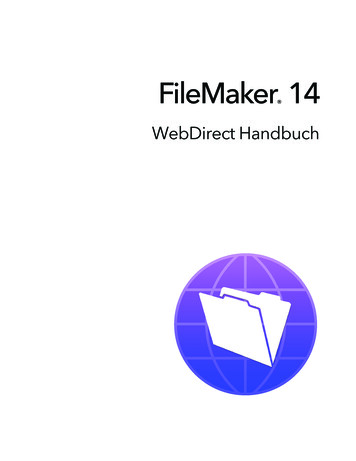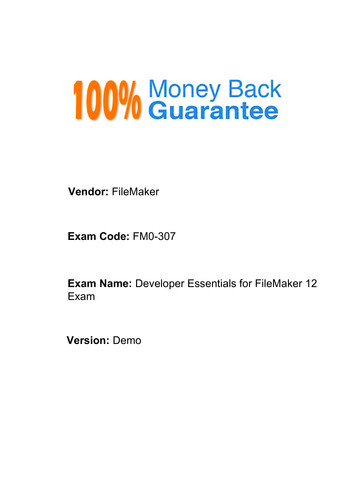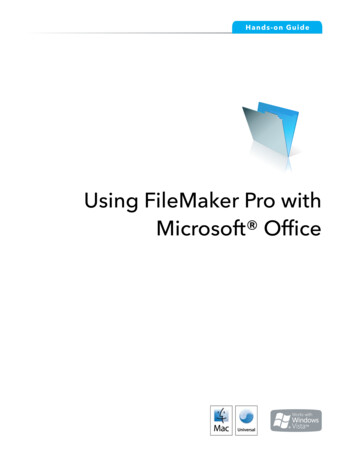
Transcription
Ha nds- on Guid eUsing FileMaker Pro withMicrosoft OfficeMaking FileMaker Pro Your Office Companionpage 1
Table of ContentsIntroduction. 3Before You Get Started. 4Sharing Data between FileMaker Pro and Microsoft Excel. 5Drag and Drop Import. 5Viewing data in different layouts. 7Saving and Sending data as an Excel File. 11Saving and Sending data as a PDF file. 12Sharing Data between FileMaker Pro and Microsoft Word. 13Storing and Sharing Data between FileMaker Pro and Office Apps. 18Sharing Data between FileMaker Pro and Microsoft Exchange,Outlook and Entourage. 21Making FileMaker Pro Your Office Companionpage 2
IntroductionFileMaker works well with the Microsoft Office line of products. With FileMaker Proyou can take a simple estimate, schedule, or contact list you created in Excel and dragand drop that file onto the FileMaker Pro application icon and it will automaticallycreate a database in FileMaker. You’ll then be able to search, sort, share and preparereports using that data instantly – and without having to re-key a thing!Are you creating individual letters, invoices and mailing labels by hand? Save yourselfcountless hours by integrating Microsoft Word and FileMaker Pro. By storing all yourcontacts, assets, and inventory records in FileMaker Pro, you can easily producecustomized letters and labels by pulling information from FileMaker Pro into Wordwithout having to type individual letters and invoices or duplicate data entry.And you can use FileMaker Pro as a digital library for all your PowerPointpresentations as well as your Word and Excel documents and files that you use overand over again. By keeping frequently used templates, graphics, tables, and chartsorganized in a database, they’ll be instantly searchable and more easily accessed byyou and anyone you choose.Making FileMaker Pro Your Office Companionpage 3
Things you can do faster and easier in FileMaker Pro Manage customer, client, and vendor details with complete searchable detailAccess, track, and collaborate with colleagues on projects and tasksTrack and manage inventory, products, and assetsOrganize and archive pictures, video and other multimedia files or createyour own digital asset tracking solution Produce customized reports and save as PDF or Excel formats Print invoices, letters and mailing labels Send targeted mailings to customersView live web information linked to your data within your databaseSet up live two-way connections to your organizations SQL dataShare databases with Windows and Mac users simultaneously over thenetwork or across the web.Before You Get StartedYou will need a copy of FileMaker Pro installed on your Mac or Windows computer. Youcan get a free 30-day trial copy of FileMaker Pro at www.filemakertrial.com. On this site,you should also download the free FileMaker Business Productivity Kit which containsfully working business database templates which you can either start to use immediately,or customize for your own business needs.www.filemakertrial.com landing pageMaking FileMaker Pro Your Office Companionpage 4
Let’s Get Started!Sharing Data between FileMaker Pro and Microsoft Excel Strengths of ExcelStrengths of FileMaker ProStoring and analyzing data in listsAnalyzing and modeling dataProducing charts and graphsBuilding a financial modelCreating basic reports Viewing information in list, form, or tableview Storing and managing virtually any type ofinformation (words, images, numbers, files) Creating and publishing customized formsand reports Connecting related information such asinventory and sales Access by multiple people at the sametimeIf you’re using Excel to manage your data, you may think you have all the informationmanagement you need. Think again. You can instantly transform your Excelspreadsheets into rich, powerful solutions that you can customize to suit your needs:4Performing searches4Printing professional quality reports4Importing and storing images, video, PDFs, PowerPoint presentations, etc.4Tracking projects, contacts, inventory4Publishing information to the web4Sharing data across a workgroup regardless of platformWith FileMaker Pro, you can instantly transform your Excel spreadsheets into richer,more powerful database solutions that let you perform searches, sort data, importimages, create reports, add links, resize columns, and more – by simply dragging anddropping your Excel spreadsheets into FileMaker Pro. It really is just that simple.Exercise 1: Drag and Drop ImportThere’s no need to re-enter the information you have stored in Excel or any otherspreadsheet. You can easily import your information following these simple steps.Making FileMaker Pro Your Office Companionpage 5
1. With your spreadsheet file closed, simply drag the Excel file onto the FileMaker Proicon.2. In the First Row Option dialog box, choose whether the first row of data containsfield names or the first record of data, then click OK.Making FileMaker Pro Your Office Companionpage 6
3. In the Create a New File Named dialog box, type a name for the new file, choose alocation, then click ok.4You now have a FileMaker Pro file with the same information as your Excel file.Once your Excel File has been converted to a FileMaker Pro file, you can now easilysearch and sort your data:4Click on any header, and FileMaker Pro will automatically sort the data for you.4Find information quickly by clicking on the Find Icon in the bar above, andthen search on any category that you wish.4Add or delete records instantly using the “New Record” or “Delete Record”icons.4Resize or re-order any column by dragging the column header to the left orrightExercise 2: Viewing your data with different types of layoutsFileMaker Pro makes it easy to create layouts, forms, and lists that look and work theway you want them to. Let’s experiment with some new layouts and add a new fieldto our database.Making FileMaker Pro Your Office Companionpage 7
1. Select the Edit Layout button on the Status Toolbar2. Drag and drop any of the field names or field value boxes that you see to a newlocation on the form.3. Double-click to change the field name or field type choosing from a variety of optionspresented on the Field/Control Setup screen. After experimenting with a few options,Click OK.4. To add a new field to your form, select the Manage button in the Status Toolbar,then choose Database. You will see the Manage Database screen.5. Type in a name for any new information you’d like to track in the Field Name box(Picture for example).6. In the Type box, choose Container from the pop-up list of all the different fieldtypes you can store in FileMaker Pro.7. Click Create, then Click OK.Now a Picture field has been added to your database’s list of available fields, and nowall you need to do is drag it to your form wherever you’d like a picture to display.Making FileMaker Pro Your Office Companionpage 8
8. Another easy way to create new layouts is with the “Layout/Report” button locatedin the top portion of the Layout screen.9. Click on the “New Layout/Report” button9. Choose the type of layout or report that you would like to create - Standard, TableView, Labels, custom. For this example, we’re going to use “Standard form”.10. On the next screen, choose what information you want to appear on your layoutand hit OK/11. Next, choose what theme or color palette you would like to use and then hitFinish.12. You now have a new Layout which you can further customize in the Layout screenas you did previously.Making FileMaker Pro Your Office Companionpage 9
Sample layout made from Layout/Report AssistantAlso be sure to check out the database templates that come free with FileMaker Pro.There are pre-designed, ready-to-use forms for managing contacts, tracking projects,organizing inventory and other popular tasks.One of the pre-designed ready-to-use formsMaking FileMaker Pro Your Office Companionpage 10
Exercise 3: Send data as an Excel file.There are times when you’ll want to save your FileMaker Pro data as an Excel file usingthe Excel Maker feature.Excel MakerCreate Microsoft Excel workbooks from your FileMaker data right from withinFileMaker, for easy sharing and analysis by Excel users.1. Choose “Save/Send Records As” from the File menu and choose Excel.Save FileMaker data directly into an Excel file2. To view Excel options, click the Options button in the Save Records As Excel dialog.For example, you can define the name of the worksheet, title, subject, author, orenter a description about the file.Making FileMaker Pro Your Office Companionpage 11
3. After saving, you can automatically open the file in Excel, and/or create an emailwith the file as an attachment, or both. Just select the appropriate options at thebottom of the Save As dialog box.4. Excellent! Your FileMaker Pro data is now saved as an Excel file and presented inthe familiar rows and columns format that Excel users appreciate.Exercise 4: Save data as a PDF file.PDF MakerSecurely share FileMaker data with people outside your FileMaker workgroup—evenpeople who don’t have FileMaker—by creating, printing, and emailing Adobe PDF files.1. Choose “Save/Send Records As” from the File menu and choose PDF to create aPDF file from all the records being browsed, the current record, or a blank form.Share FileMaker data through PDF files2. Click the Options button to access all PDF options available from within the actual Acrobatapplication: Document, Security, and Initial View. By selecting options on the Securitypanel, for example, you can control the right to open, print, or modify the document.Making FileMaker Pro Your Office Companionpage 12
Sharing Data between FileMaker Pro and Microsoft WordUsing FileMaker as a Data Source for a Word Mail Merge DocumentIt is easy to add a new letter layout within a FileMaker Pro file and print a letter toa single customer, a specific group of customers based on search criteria, or allcustomer records in a database.You may however have an existing letter template in Word that you would like touse as the basis of a mail merge document, using customer records that are held inFileMaker Pro. You can export a selected set of records from a FileMaker database, asa Merge file, which can be used as a recipient list for a Word mail merge document.Step 1: Preparing a Letter for Mail Merging in Microsoft WordLaunch Microsoft Word and open your existing letter template document:Figure 1: A sample marketing letter written in Word,ready for merge fields to be addedMaking FileMaker Pro Your Office Companionpage 13
Step 2: Creating the Merge Data File in FileMakerYou can export customer records in your FileMaker Pro database to create a new mergedata source file. You can either select all records in your Contacts file to include in the newmerge file, or reduce the list of recipients by searching for a specific group of customers.When you are happy with your chosen set of records, select the menu option:File Export Records.The Export Records to File dialog box will appear. The file name and type options, areshown below. Type a name for the new exported records file. Click the down arrowto the right of the Save as type field and choose Merge Files from the list of file types.Choose a folder location to save the new merge file to, and click the Save button.Figure 2: The file options in the Export Records to File dialog boxMaking FileMaker Pro Your Office Companionpage 14
The Specify Field Order for Export dialog box will appear. As a default setting, the listof fields displayed on the left, is based on the current layout. Highlight each of thefields you want included in your mail merge letter, and click the Move button eachtime. When you are happy with your selected fields, click the Export button. A newmerge file will now be created in the location you select.Figure 3: The Specify Field Order for Export dialog boxStep 3: Linking the Merge Data File to the Merge LetterSwitch back to the letter document in Word and select the menu option Tools MailMerge Manager, or Tools Letters and Mailings Mail Merge depending uponwhich version of Microsoft Word you are using. The Mail Merge task pane will open.Use the hyperlinks in the task pane to navigate through the mail merge process.See screens below for process.Making FileMaker Pro Your Office Companionpage 15
Figure 4: Selecting the Mail Merge Manager feature within Microsoft WordFigure 5: Select either “open data source” and choose your FileMaker Mail Mergedocument, or in newer versions of Microsoft Word, you can also choose FileMakerand link directly to your FileMaker database.Making FileMaker Pro Your Office Companionpage 16
Figure 6: Drag and match your database fields to the address fields in your letter.After fields are matched, preview the records then merge the data into your letter.Figure 7: Final letter with merged data, ready for mailing.Making FileMaker Pro Your Office Companionpage 17
Storing and Sharing Data between FileMaker Pro and all MicrosoftOffice ApplicationsUse FileMaker as an Asset Library to Store Office DocumentsThere are many professional firms using FileMaker Pro as an electronic asset library,to store business documents. You can store virtually any type of file in a FileMakercontainer field and if you have the original document application installed on yourcomputer, you can open the file from within FileMaker.Step 1: Opening the Document Library FileMaker TemplateWe can use the Document Library template that ships with FileMaker Pro, to buildan example asset library file. Launch FileMaker Pro, and on the Quick Start screen,choose the “Create a database using a Starter Solution” button. Select the DocumentLibrary from the set of database templates, shown in Figure 1 below. Click the OKbutton to create the new file.Figure 1: Select the Document Library template from the Quick Start ScreenMaking FileMaker Pro Your Office Companionpage 18
Step 2: Inserting a File into the Document Library FileFigure 2: Use the Document Library file to store details on a PowerPoint PresentationThe Document Library Form View layout includes a container field displayed as awhite rectangle with the label ‘Picture’ behind it. In addition to a description of thefile, you can store the file itself, or a reference to it, within the container field. Clickthe container field and choose Insert File from either the mouse menu, or the Insertmenu. Use the Insert File dialog box, which then appears, to select the document thatyou want to add to the FileMaker record.At the base of the dialog box there is a check box that gives you the option to storeonly a reference to the file, shown in Figure 3. If you select Store only a reference tothe file, FileMaker Pro doesn’t import the file, it only keeps track of where it is on yourhard disk, saving disk space.Making FileMaker Pro Your Office Companionpage 19
Figure 3: The file storage option within the Insert File dialog boxWhen needed, you can choose Export Field Contents from the mouse menu or theEdit menu to export a copy of the stored document.Step 3: Inserting a Linked Object into the Document Library FileYou may prefer to store the document in FileMaker Pro as a linked object. Thismethod means that you will be able to launch the original file from within FileMaker.Click the container field and select the Insert File option from the mouse menu or theInsert menu. The Insert Object dialog box will open, as shown in Figure 4. At the baseof the dialog box be sure to check the box that gives you the option to store only areference to the file. This will allow you to open the file within FileMaker Pro by simplyclicking on the file in the container fieldFigure 4: Use the Insert File dialog box to add a link to the original file in a container fieldMaking FileMaker Pro Your Office Companionpage 20
Using The Container FieldWith the Container Field, you can add, store, and archive virtually any type of file orinformation you want to your database including images, movies, sounds, MicrosoftOffice files, Adobe PDF files and much more. Store several terabytes of information inany single database. Use FileMaker Pro to keep track of projects, inventory, contracts,and store the original Word, PDF, Excel, PowerPoint or JPEG files.Sending data from FileMaker Pro to Microsoft Exchange, Outlookand EntouragePart I Creating Emails From within FileMaker ProUsing the Send Mail Command to Create Emails From within FileMaker ProIt is quite easy to send email from within FileMaker using the Send Mail buttoncommand. From your contacts or other database, from the File Menu, select “Send Mail”Figure 1: Selecting the “Send Mail” command within FileMaker ProMaking FileMaker Pro Your Office Companionpage 21
Next, select the email field from your database, add in a subject line, message, and anyfile attachment that you wish to send.Figure 2: Selecting the “email field” to mail to.Once all the fields are filled out, simply hit the “OK” button, and FileMaker will sendthe files and attachments to your email client out box.Figure 3: Email ready to be sent from the out box within the email clientMaking FileMaker Pro Your Office Companionpage 22
Next StepsCongratulations! You’ve taken the first step toward managing people, projects, assetsand more - the easy way!You might be interested in the free resources available on the FileMaker websites(www.filemaker.com and www.filemakertrial.com). These free resources include: Pre-designed, ready-to-use databases for common everyday informationmanagement needs. Resource Guides that provide a comprehensive list of FileMaker software andservices, as well as trainers and consultants who specialize in FileMaker software. Customer stories so you can read how others from around the world use FileMakerPro to manage their information better. FileMaker News a monthly electronic newsletter containing notifications of softwareupdates, tips and tricks for using FileMaker Pro in new ways, special offers, andmore! 2009 FileMaker, Inc. All Rights Reserved. FileMaker and the file folder logo are registered trademarks and/or trademarks of FileMaker, Inc. in the U.S. and other countries. Mac is a trademark of Apple Computer, Inc.registered in the U.S. and other countries. Microsoft, Windows and the Windows logo are registered trademarksof Microsoft Corporation. Adobe and Acrobat are either registered trademarks or trademarks of Adobe SystemsIncorporated in the U.S. and/or other countries. The example companies, organization, products, domain names,e-mail addresses, logos, people, places and events depicted are purely fictitious, and any resemblance to existingpersons and companies is purely coincidental.Making FileMaker Pro Your Office Companionpage 23
Create Microsoft Excel workbooks from your FileMaker data right from within FileMaker, for easy sharing and analysis by Excel users. 1. Choose “Save/Send Records As” from the File menu and choose Excel. Save FileMaker data directly into an Excel file 2. To view Excel options, click the Options but
